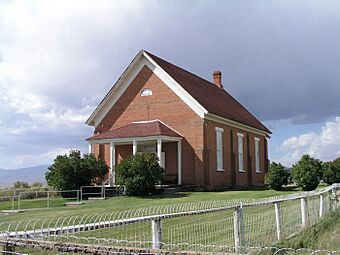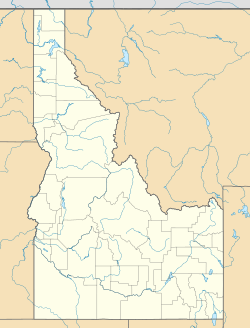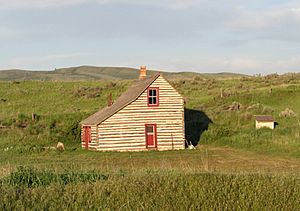Chesterfield, Idaho facts for kids
Quick facts for kids |
|
|
Chesterfield Historic District
|
|

Chesterfield LDS Meetinghouse
|
|
| Location | Caribou County, Idaho |
|---|---|
| Nearest city | Bancroft, Idaho |
| Area | 2,160 acres (870 ha) |
| Built | 1881 |
| Architectural style | Greek Revival, Queen Anne, Hall-and-parlor; I-house |
| NRHP reference No. | 80001297 |
| Added to NRHP | December 4, 1980 |
Chesterfield is a fascinating ghost town in Caribou County, Idaho, United States. A ghost town is a place where people used to live, but now it's mostly empty. It sits in Gem Valley about 5,446 feet (1,660 meters) high.
This historic community has a cemetery and old buildings from the Church of Jesus Christ of Latter-day Saints (LDS Church). These include a former meeting house, an amusement hall, and a tithing house.
Chesterfield was founded in 1881 by Mormon settlers. It was located along the famous Oregon Trail. However, when a railroad was built through Bancroft to the south, Chesterfield started to lose its importance. Farming problems also led to people leaving. By the late 1930s, the town was mostly empty.
Today, Chesterfield is a popular place for visitors. You can take guided tours and explore a museum. It's like stepping back in time!
In 1980, Chesterfield was added to the National Register of Historic Places. This means it's a special place worth protecting. It's also on the Mormon Historic Sites Foundation's list of important Mormon historical sites. The historic area covers 2,160 acres and includes 41 buildings and eight other important spots. Some buildings show cool styles like Greek Revival and Queen Anne.
Contents
How Chesterfield Began
In 1879, Chester Call and Christian Nelson started a horse ranch here. Chester thought it was a great place to live. He told his family and friends, and they decided to settle there in 1881 and 1882.
The first settlers built their homes near the Portneuf River. Unlike many Mormon towns, Chesterfield wasn't planned by church leaders. It grew naturally. Also in 1881, the Union Pacific Railroad began building the Oregon Short Line Railroad nearby. The new settlers sold logs and railroad ties to the railroad, which helped them earn money.
In 1883, leaders from the LDS Church visited. They asked the settlers to move away from the river's flood plain and build a central village. The current Chesterfield townsite was chosen in the foothills. Like other traditional Mormon towns, Chesterfield was laid out in a grid pattern. It had 35 blocks, each about ten acres. By 1890, only the LDS meetinghouse and a store were built. This was because of a mistake in a government survey.
Life in Chesterfield
The LDS Chesterfield Ward (a local church group) was formed in 1884. It had 136 people in 24 families. By 1900, the population grew to 418 people in 73 families.
However, the area faced tough times. Very cold winters and a drought between 1898 and 1900 caused many people to leave in 1901. Another difficult winter and a money crisis in 1907 led to more people moving away. By 1908, fewer than 400 people lived in the area.
The population grew again, reaching almost 700 people by 1920. But problems in the 1920s, like money troubles and farming difficulties, started the decline of Chesterfield. By 1928, only about 425 people remained. Most buildings were empty before 1941, when the school closed. The general store closed in 1958. By 1970, only about 20 people lived in historic Chesterfield.
Exploring Historic Buildings
The Meetinghouse
The LDS Meetinghouse is the most famous and best-kept building in Chesterfield. It was built between 1887 and 1892. It was a central place for the community.
The Amusement Hall
The original Amusement Hall was built in 1895, right next to the Meetinghouse. This building was the heart of social life in Chesterfield. It had a big room with a hardwood dance floor and a stage. Over time, it fell into disrepair. But it was beautifully restored between 1999 and 2003.
The Tithing Office and Granary
LDS members pay tithing to their church. Around 1900, most people didn't have cash. So, they paid with things like grains, vegetables, eggs, and farm animals. The Tithing Office and Granary were built in 1900. Grain donations were stored in the Granary. The Tithing Office was where members paid their tithing. It also acted like a warehouse and general store, giving goods to those who needed them.
Homes of Chesterfield
The Nathan Barlow House was built around 1900. Nathan Barlow was the postmaster and owned the general store. After the money crisis of 1907 and a harsh winter, he lost everything and moved away. His home was restored in 2009, with his family helping to furnish it.
The Ira Call cabin is a unique saltbox style home. For a short time, it housed two families.
Aunt Ruth Call David's cabin was built in 1881 and 1882. It was made of red pine logs and had a dirt floor. Aunt Ruth was a Native American woman adopted by Chester Call's parents. She was the town's midwife and helped deliver most of the babies.
Famous People from Chesterfield
- Frank Chester Robertson, a writer of Western stories.




